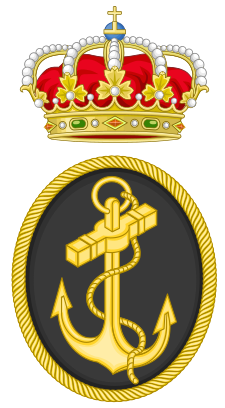....
The Spanish (Española) Navy or officially, the Armada, is the maritime branch of the Spanish Armed Forces and one of the oldest active naval forces in the world. The Spanish Navy was responsible for a number of major historic achievements in
navigation, the most famous being the discovery of America and the first global circumnavigation by Elcano. For several centuries, it played a crucial logistical role in the expansion and consolidation of the Spanish Empire, and defended a vast trade network across the
Atlantic Ocean between the Americas and Europe, and the Manila Galleon across the
Pacific Ocean between the Philippines and the Americas.
The Spanish Navy was the most powerful maritime force in the world from the late 15th century to the early 18th century. In the early 19th century, with the loss of most of its empire, Spain transitioned to a smaller fleet but maintained a major shipbuilding industry which produced important technical innovations. The Spanish Navy built and operated the first military submarines, made important contributions in the development of destroyer warships, and again achieved a first global
circumnavigation, this time by an ironclad vessel.
The main bases of the Spanish Navy are at Rota, Ferrol, San Fernando and Cartagena.
2022
Subordinate to the Spanish Chief of Naval Staff, stationed in Madrid, are four area commands: the Cantabrian Maritime Zone with its headquarters at Ferrol on the Atlantic coast; the Straits Maritime Zone with its headquarters at San Fernando near Cadiz; the Mediterranean Maritime Zone with its headquarters at Cartagena; and the Canary Islands Maritime Zone with its headquarters at Las Palmas de Gran Canaria. Operational naval units are classified by mission and assigned to either the combat forces, the protective forces, or the auxiliary forces. Combat forces are given the tasks of conducting offensive and defensive operations against potential enemies and for assuring maritime communications.
Their principal vessels include a carrier group, naval aircraft, transports, landing vessels,
submarines, and missile-armed fast attack craft. Protective forces have the mission of securing maritime communications over both ocean and coastal routes, securing the approaches to ports and maritime terminals. Their principal components are frigates, corvettes, and minesweepers. It also has marine units for the defense of naval installations. Auxiliary forces are responsible for transportation and provisioning at sea and has diverse tasks like coast guard operations, scientific work, and maintenance of training vessels. In addition to supply ships and tankers, the force included destroyers and a large number of patrol craft.
Until February 2013, when it was decommissioned because of budget cuts, the second largest vessel of the Armada was the aircraft carrier Principe de Asturias, which entered service in 1988 after completing sea trials. Built in Spain, it was designed with a "ski-jump" takeoff deck. Its complement was 29 AV-8 Harrier II vertical (or short) takeoff and landing (V/STOL) aircraft or 16 helicopters designed for antisubmarine warfare and to support marine landings.
As of 2012, the Armada had a strength of 20,800 personnel.
As of 2018, there are approximately 138 vessels in service within the Navy, including minor auxiliary vessels. A breakdown includes an amphibious assault ship (also used as an
aircraft
carrier), amphibious transport docks, frigates, submarines, mine countermeasure vessels, patrol vessels and a number of auxiliary ships. The total displacement of the Spanish Navy is approximately 220,000 tonnes.

ADMINISTRATION
The Spanish Navy shares the organization model of its two sister services – the Spanish Army and the Spanish Air and Space Force. Each of them consists of a Headquarters (Cuartel general), a Force (Fuerza, composed of the operational units) and a Force Support (Apoyo a la fuerza, composed of administration, logistical and training units). For historical traditions the Force of the Spanish Navy is called Fleet (Flota) and the two terms are used interchangeably.
At the head of the Navy is an Almirante general (a four-star rank reserved for the Chief of the Spanish Navy and the Chief of the Spanish Armed Forces, when the latter position is held by a naval officer), denominated AJEMA or Admiral Chief of the General Staff of the Navy (Almirante Jefe de Estado Mayor de la Armada).
Counterintuitive to this official designation he holds authority over all three components of the service and the officer, who actually functions as Chief of Staff is a three-star Almirante, designated Admiral Deputy Chief of the General Staff of the Navy (Almirante Segundo Jefe del Estado Mayor de la Armada or 2º AJEMA)

The Meteoro-class offshore patrol vessel, also known as Buque de Acción Marítima (BAM), are new modular offshore patrol vessels of the Spanish Navy adapted to different purposes from a common base, manufactured by Navantia. The BAMs combine high performance with mission versatility, a high commonality with other ships operated by the Spanish Navy. Acquisition and lifecycle costs are reduced.


